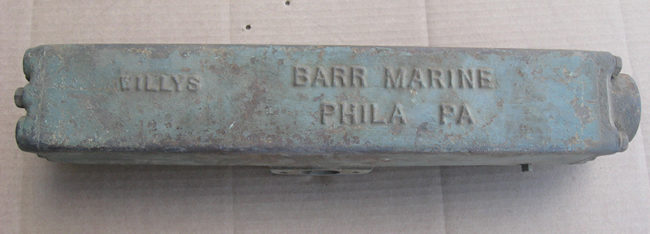UPDATE: Rudy has a similar exhaust manifold, but it is cast iron.
Dave writes that he picked up this boat marine inboard exhaust manifold. The former owner said he tried to google it, but could find no information. It came off a Jeep mb motor. Anyone recognize it?






There was a company in Chicago, IL during WW2 that made all sorts of aluminum products. They might have been the manufacture of the part. They made mess kits for the B-17 and B-24 bombers along with a lot of other manufacturing/ smelting contracts they had for the war effort..
My question is, what was it’s purpose? Heat or cool water? For use in extreme cold weather? Muffle exhaust sound? Jet direction drive? Me not know.
Somewhere on this site is a pub with AG-1 HELMCO Unit 4 Type IV as a title. Maybe someone can find it?
Lots of interesting pubs.
https://archive.org/details/wwIIarchive?and%5B%5D=mediatype%3A%22texts%22&sort=-reviewdate&page=10
Generally boat motors suck up lake water for cooling. One way to get rid of it is to send it out with the exhaust. Keeps engine bay cooler. Exhaust is quieter. This is a little simpler than it is in real world but close.
Steve,
I found the reference to Helmco, but it is related to food prep:
https://archive.org/details/FeedingInFlight?q=HELMCO+Unit+4
– Dave
I wonder if it was possibly used on the amphibious Jeeps? The aluminum one with a couple of side draft carbs would really make quite a “show piece”.
Willys made marine engines as well, I have seen them. Yes, this is to make the exhaust go out under the waterline, that’s the way it was done for years.
In a classic boat set-up, cold water from whatever you’re floating upon, is routed by external water pump through the exhaust manifold. A portion enters the block (now warmed) for circulation by the regular water pump. The other portion may exit into the exhaust plumbing. After circulating through the block to pick up additional heat, it also is blended back into the exhaust stream to cool the gases, and out the transom, back into the body of water. The injection point is below the point of possible entry into the cylinders. And there are as many boat cooling schemes, as there are ice cream flavors. Keep in mind these engines would have been likely installed in wooden boats, and below decks or engine hutches, so the normally high exhaust manifold temps could have caused fires. And that makes for a bad fishing day.